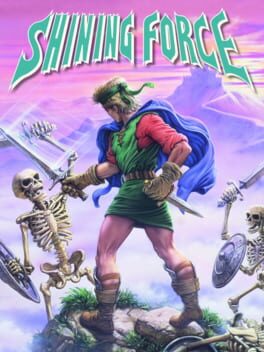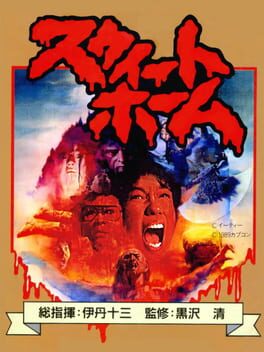novalin
Bio
Nothing here!
Badges

GOTY '23
Participated in the 2023 Game of the Year Event

1 Years of Service
Being part of the Backloggd community for 1 year

Liked
Gained 10+ total review likes

Noticed
Gained 3+ followers
Favorite Games
003
Total Games Played
000
Played in 2024
000
Games Backloggd
Recently Reviewed See More
If you haven’t heard of Sweet Home then you are not alone, as it was only ever officially released in Japan. The version I am playing is a translated reproduction cartridge, meaning it isn’t an original NES game, but you wouldn’t know that by the looks of it. Sweet Home, produced by Capcom, is a precursor to the Resident Evil (Biohazard) series. Similar to Resident Evil, it’s a survival horror themed game that takes place in a creepy mansion filled with creatures and zombies. The mechanics draw similarities as well, as you progress by collecting items, backtracking, and using those items to progress in the form of light puzzles. Notes left behind offer clues to both your advancement and the grander story. Even the ability to toggle between characters is later found in Resident Evil Zero.
Where Sweet Home differs from the Resident Evil lineage the most is two-fold: 1) it’s an RPG, and 2) what makes this game so unique is how you partner with the five playable characters. With regards to the latter, the dynamic of grouping (and ungrouping) with your fellow trapped survivors is what makes the game unique and special. You are restricted to no more than three characters in a party at a time, and each character can only hold two items, in addition to their special item. This forces the player to make strategic decisions. Do I have a good set of items for what I anticipate ahead? If I need items from the group of two I left behind will they be able to safely catch up to the party of three? You’re constantly making trade-offs, and while on occasion it feels somewhat tedious, it mostly feels engaging.
And at times, safety in numbers can backfire. I find myself often toggling between holding a stance that the clues are too literal, and thus, too easy, and wishing the game was more challenging. And then, just minutes later, my entire party of three will fall into a pit, hanging for their lives, and because I wasn’t careful enough my remaining party of two isn’t able to get to them in time to save them. It’s actually moments like these that really up my appreciation for this game as it’s these types of creative surprises that adds flavor.
While I save often in this game, in fear of permanently losing a character, there was a moment that occurred early in the game where I decided to not reset and, instead, decided to accept and carry on. I had crossed a pit to obtain an essential item, by placing a log to form a bridge. My party of three doubled back after gathering the item, and this is when the character in the center of the line broke the bridge and hung to the edge. I was able to pull the character back up, but this meant that one of my other characters, Asuka, was now stranded on the other side. I ended up leaving Asuka on that lonely island for a huge portion of the game, always knowing, or at least hoping, that I would come back. It was a promise I made both to myself as a player as well as between the characters in the context of the game world. Eventually I found more logs, returned, and saved my friend. It was a sense of relief to finally be reunited. That was also when I realized that Asuka, all along, had a log in her inventory that she could have used to cross that gap. I laughed to myself.
The survival horror theme is bolstered even further by the ways in which characters become separated. If you’re like me, you occasionally take unnecessary risks in games (especially if you just saved your progress) in an effort to push the boundaries of the game. For example, there are spirits that will pull a character away from their group, plopping them in a room many screens away. The wisest decision in this moment would be to take the remaining two characters that are still bound together, and to have them navigate to their lost friend. However, like foolish teenagers in countless horror movies, I will often take my solo character and journey on, acting as if I am confined to the perspective of that person. Ask yourself, if you were taken from your friends by ghosts, would you sit still in a strange room? Probably not. Now, a solo trek like this can be disastrous, as you might break a flimsy plank that stretched across a pit, with no one to pull you up. Or you will face enemies alone, and with a finite number of healing items available in the game, this isn’t wise (assuming you even have an item to heal yourself with). This is actually where another ingenious mechanic comes into play: the ability to call for help. In this mode, another character (or set of characters) has limited time to run towards their comrade and assist them. It’s a heart-pounding moment.
Further on the topic of encounters, as mentioned before, this is an RPG, albeit a rather atypical one. Battles are randomly triggered, with the exception of the fights that ensue when you come into direct contact with enemies that traverse across some of the screens. The battles are rather simple, made up primarily of attacks and prayer (think magic). Many of the traditional systems found in RPGs, such as collecting coins, purchasing weapons and items, and resting at inns to regain health, do not exist in Sweet Home (nor do they have a place here). Rather, there is no currency, weapons and items are discovered, and hit points and prayer points are replenished only with tonics.
The environments powerfully convey the mood. In this vast mansion you twist and turn down hallways, up and down stairs leading you to great heights and depths, and explore the outer areas surrounding the property. Each section is truly unique, ranging from underground labyrinths to a lakeside forest. The top-down view is contrasted by more detailed scenes of paintings and monuments, and the occasional open door animation.
Most areas, in addition to having their own visual complexity, are accompanied by a variety of music compositions that fit snugly in the horror genre. A rolling low tone base line is accented by squealing highs. There is a deliberant tempo juxtaposition between the moderate beats-per-minute (BPM) of the exploration music and the upbeat, panic inducing songs that quickly loop and build anxiety when you battle enemies and suffer from poison.
Even with the limitations of the NES, Sweet Home managed to nail the theme of what survival horror should be. You’re scared. You’re often alone. Your resources are limited. Danger lurks behind every corner. The atmosphere is terrifying. A sinister backstory slowly reveals itself, making the world that much more frightening. Death is final.
Not only did Sweet Home bring me back to the joy of experiencing a new NES experience, it also reminded me of the pleasure of solving mysteries through the use of taking notes. Note taking, for many, in and outside the context of gaming, is considered a chore. Growing up in the days of the NES, however, it was not just helpful at times, but often essential. Drawing maps, scribbling down clues, recording passwords...these are all staples of the NES experience.
Where Sweet Home differs from the Resident Evil lineage the most is two-fold: 1) it’s an RPG, and 2) what makes this game so unique is how you partner with the five playable characters. With regards to the latter, the dynamic of grouping (and ungrouping) with your fellow trapped survivors is what makes the game unique and special. You are restricted to no more than three characters in a party at a time, and each character can only hold two items, in addition to their special item. This forces the player to make strategic decisions. Do I have a good set of items for what I anticipate ahead? If I need items from the group of two I left behind will they be able to safely catch up to the party of three? You’re constantly making trade-offs, and while on occasion it feels somewhat tedious, it mostly feels engaging.
And at times, safety in numbers can backfire. I find myself often toggling between holding a stance that the clues are too literal, and thus, too easy, and wishing the game was more challenging. And then, just minutes later, my entire party of three will fall into a pit, hanging for their lives, and because I wasn’t careful enough my remaining party of two isn’t able to get to them in time to save them. It’s actually moments like these that really up my appreciation for this game as it’s these types of creative surprises that adds flavor.
While I save often in this game, in fear of permanently losing a character, there was a moment that occurred early in the game where I decided to not reset and, instead, decided to accept and carry on. I had crossed a pit to obtain an essential item, by placing a log to form a bridge. My party of three doubled back after gathering the item, and this is when the character in the center of the line broke the bridge and hung to the edge. I was able to pull the character back up, but this meant that one of my other characters, Asuka, was now stranded on the other side. I ended up leaving Asuka on that lonely island for a huge portion of the game, always knowing, or at least hoping, that I would come back. It was a promise I made both to myself as a player as well as between the characters in the context of the game world. Eventually I found more logs, returned, and saved my friend. It was a sense of relief to finally be reunited. That was also when I realized that Asuka, all along, had a log in her inventory that she could have used to cross that gap. I laughed to myself.
The survival horror theme is bolstered even further by the ways in which characters become separated. If you’re like me, you occasionally take unnecessary risks in games (especially if you just saved your progress) in an effort to push the boundaries of the game. For example, there are spirits that will pull a character away from their group, plopping them in a room many screens away. The wisest decision in this moment would be to take the remaining two characters that are still bound together, and to have them navigate to their lost friend. However, like foolish teenagers in countless horror movies, I will often take my solo character and journey on, acting as if I am confined to the perspective of that person. Ask yourself, if you were taken from your friends by ghosts, would you sit still in a strange room? Probably not. Now, a solo trek like this can be disastrous, as you might break a flimsy plank that stretched across a pit, with no one to pull you up. Or you will face enemies alone, and with a finite number of healing items available in the game, this isn’t wise (assuming you even have an item to heal yourself with). This is actually where another ingenious mechanic comes into play: the ability to call for help. In this mode, another character (or set of characters) has limited time to run towards their comrade and assist them. It’s a heart-pounding moment.
Further on the topic of encounters, as mentioned before, this is an RPG, albeit a rather atypical one. Battles are randomly triggered, with the exception of the fights that ensue when you come into direct contact with enemies that traverse across some of the screens. The battles are rather simple, made up primarily of attacks and prayer (think magic). Many of the traditional systems found in RPGs, such as collecting coins, purchasing weapons and items, and resting at inns to regain health, do not exist in Sweet Home (nor do they have a place here). Rather, there is no currency, weapons and items are discovered, and hit points and prayer points are replenished only with tonics.
The environments powerfully convey the mood. In this vast mansion you twist and turn down hallways, up and down stairs leading you to great heights and depths, and explore the outer areas surrounding the property. Each section is truly unique, ranging from underground labyrinths to a lakeside forest. The top-down view is contrasted by more detailed scenes of paintings and monuments, and the occasional open door animation.
Most areas, in addition to having their own visual complexity, are accompanied by a variety of music compositions that fit snugly in the horror genre. A rolling low tone base line is accented by squealing highs. There is a deliberant tempo juxtaposition between the moderate beats-per-minute (BPM) of the exploration music and the upbeat, panic inducing songs that quickly loop and build anxiety when you battle enemies and suffer from poison.
Even with the limitations of the NES, Sweet Home managed to nail the theme of what survival horror should be. You’re scared. You’re often alone. Your resources are limited. Danger lurks behind every corner. The atmosphere is terrifying. A sinister backstory slowly reveals itself, making the world that much more frightening. Death is final.
Not only did Sweet Home bring me back to the joy of experiencing a new NES experience, it also reminded me of the pleasure of solving mysteries through the use of taking notes. Note taking, for many, in and outside the context of gaming, is considered a chore. Growing up in the days of the NES, however, it was not just helpful at times, but often essential. Drawing maps, scribbling down clues, recording passwords...these are all staples of the NES experience.







